A Spanish Ramble
Copyright 2000 © Spencer Rugaber
I returned yesterday from seventeen days in Spain, visiting Madrid,
Asturias, and Barcelona, tired but enriched. Herein relate my experiences
which may provide some guidance for you.
-
Sunday, July 16 - Monday, July 17:
-
Flew into Madrid on Delta with my family (wife and two daughters, aged
21 and 18). Both daughters could speak Spanish from school and previous
trips. I had twelve weeks of Spanish in eighth grade, a long time ago,
which also helped a little. There was no problem with the flight, other
than, as is typical in going from Atlanta to Europe, you arrive in the
early morning already tired. The taxi driver found the hotel but charged
a lot to handle our baggage. (At least until the Euro kicks in, Spanish
currency is the peseta (pta.), worth about .6 cents, 170 to the dollar).
So the mileage cost about 2300 ptas; and the luggage was another 1700.
I questioned this, using my daughter as an interpreter, without success.

-
The hotel was the Wellington, centrally located just north of Parque
del Retiro, right on the Red line of the Metro, which, unfortunately
was off-line while we were there. But we were still close enough to either
walk to where we wanted to go or walk to the next nearest stop, about two
blocks away. I made a wise choice in asking for a room away from the street
where a lot of noisy construction was going on. The rooms were nice, and
the hotel featured an elaborate buffet breakfast to get us started in the
mornings.

-
While the others napped on Monday afternoon, I explored Retiro,
an extensive, well maintained urban park featuring a lake, a monument,
a wide variety of trees, flowers, and sculpture, and lots of well shaded
benches. It was so nice, in fact, that after an hour or so, I walked back
to get my wife, who was now awake, and take her for a visit while our daughters
(who have been known to sleep as long as fifteen hours at a stretch), continued
to catch up on sleep. While in the park, we stopped for a limón
granizado (an icy lemon drink) and watched the swans chase off the ducks
at the south end of the lake.

-
Before leaving for dinner, we delivered my younger daughter to a friend
and her aunt for a bus trip toward Ávila where she would visit for
several days.
-
My elder daughter had spent two weeks in Madrid as part of a school program
in 1999, so on her recommendation, we took the Metro to Puerta del Sol
and wandered for a bit until we found a restaurant she had eaten at previously,
the El Rincon de Roque. It was inexpensive, friendly, and willing
to serve us as early as 19:30 (Spain uses the 24 hour clock). Restaurants
open late in Spain, some not until 9:30 or so, but our bodies had not yet
adjusted to the six hour time difference from Atlanta. So we welcomed the
opportunity to experience jamón (ham), gazpacho, and pollo (chicken).
Back to the hotel for a full night's sleep, ready to tackle the Prado on
Tuesday.
-
Tuesday, July 18:
-
Tuesday would be our only full day in Madrid, so we made it a long one,
starting with the Prado, or more accurately, the Museo del Prado,
one of the world's great art museums. We walked there from our hotel in
about twenty minutes, this time passing by the Plaza de la Independencia.
 It
was during this walk that we had the only encounter during our trip.
We had been warned and had read several descriptions of pickpocket scams,
so it was not surprising that a woman carrying a baby approached my wife,
using one of the advertised maneuvers. We walked quickly by without incident,
but with heightened awareness.
It
was during this walk that we had the only encounter during our trip.
We had been warned and had read several descriptions of pickpocket scams,
so it was not surprising that a woman carrying a baby approached my wife,
using one of the advertised maneuvers. We walked quickly by without incident,
but with heightened awareness.
-
When we got to the museum, we waited in line to buy tickets, without realizing
that there were two lines, one going in the ground floor and one for the
first floor. Of course we chose the wrong one, slower and hotter, but it
did give us a chance to share experiences with other tourists. This was
our first example of poor or missing signage, which would plague
us throughout our visit to Spain.
-
But once inside, we were overwhelmed with three large floors of beautiful
paintings, sculptures, and furniture. So extensive is the collection that
we spent our whole day there without seeing either of the other couples
we were to meet for dinner, who also were at the Prado all day. The featured
artists, Goya and Velázquez, are well represented as are other Spanish
and continental painters, but three highlights stand out for me. The first
is El Cardinal by Raphael, as vibrant a portrait as I have ever
seen; Goya's Black Paintings surprised me with their bleakness;
and then there is Bosch. I had been alerted by a colleague to have a look
"into the basement", but now there is a whole room devoted to The Garden
of Delights and its copies, truly a work of creative genius. We ate
lunch in the adequate museum cafe before completing our perusal and then
headed back through the park to our hotel.
-
For dinner, we took a taxi back into the old section of Madrid to what
is reputedly the oldest restaurant in the world, Botín, at
Calle de Cuchilleros 17. Here we met up with my wife's father and stepmother,
her daughter and her fiancé. We carefully watched our heads as we
maneuvered down a narrow staircase to our table. The place did indeed look
old. This would be our first experience with Spanish appetizers called
tapas,
which are diverse, tasty, and, if you aren't careful, will distract you
from your entree, which in my case was one of the house specialties, roast
suckling pig. We complemented the food with Spanish wine and finished with
flan, a dessert custard. The food was quite tasty, but as we would soon
learn to our joy, the other restaurants we would visit were even better.
-
We decided to finish the evening by searching out a place to watch flamenco
dancing. Although this art form is from Andalusia in southern Spain, both
Madrid and Barcelona offer several restaurants where it can be seen. We
chose the Café de Chinitas and were able to get a table near
the stage. The two groups we saw featured between two and five female dancers
and one or two male singers. One of the groups also had a drummer. The
singers only occasionally contributed while the women worked hard on what,
I learned later, were their improvisations. I was impressed by their athleticism
and endurance, but the dancing is, for the most part, an expression of
anguish and despair.
-
Wednesday, July 19:
-
Before we left Atlanta, I had asked my older daughter what we should see
and do in Madrid, and she strongly recommended that we visit Santa Cruz
del Valle de los Caídos near El Escorial in Madrid province.
 So, on the morning of the 19th, we walked to the nearby Estación
de Recoletos where we caught the train to El Escorial, about
a one hour ride. There we engaged a taxi driver who, for 3500 ptas. would
drive us the 13 kilometers to the monument and wait for us for one hour.
Supposedly, there is a bus that would also have taken us, but a quick search
and a few questions did not suffice, so we opted for the taxi. The memorial
is the grave of Franco and of forty thousand soldiers who fought
in the Spanish civil war. It is carved into the side of a mountain and
topped with a 150 meter concrete cross. The basilica is fronted with a
broad, stepped plaza
So, on the morning of the 19th, we walked to the nearby Estación
de Recoletos where we caught the train to El Escorial, about
a one hour ride. There we engaged a taxi driver who, for 3500 ptas. would
drive us the 13 kilometers to the monument and wait for us for one hour.
Supposedly, there is a bus that would also have taken us, but a quick search
and a few questions did not suffice, so we opted for the taxi. The memorial
is the grave of Franco and of forty thousand soldiers who fought
in the Spanish civil war. It is carved into the side of a mountain and
topped with a 150 meter concrete cross. The basilica is fronted with a
broad, stepped plaza  and
bounded by two columned wings. The interior is also concrete with black,
metallic gates and light fixtures. The juxtaposition of the concrete and
metallic décor with the religious decorations and purpose was stark
and effective. It brought home to us the cost of civil war.
and
bounded by two columned wings. The interior is also concrete with black,
metallic gates and light fixtures. The juxtaposition of the concrete and
metallic décor with the religious decorations and purpose was stark
and effective. It brought home to us the cost of civil war.
-
We returned to Madrid, and my daughter and I journeyed on the Metro to
Atocha
bus station where we met my other daughter returning from her visit with
her friend. The station was large, the signs uninformative, and her bus
was early. We were lucky when she spotted us at the information booth.
-
We ate that night at La Fonda, on Lagasca near our hotel, recommended by
the hotel desk. Another good meal to prepare us for our journey on the
next day to Asturias.
-
Thursday, July 20:
-
On Thursday, we traveled to our second destination: a rented house in Puertas
de Vidiago, Asturias Province, on the north central coast of Spain.
Because of our luggage, we took a taxi from the Madrid hotel to Chamartin
train station, where we had tickets for Santander. Besides the tickets,
we also had seat reservations, costing an extra ten dollars per person.
My elder daughter had learned the hard way on an earlier visit that tickets
alone were insufficient if the train was full.
-
The trip was pleasant and uneventful, arriving in Santander on schedule
in the mid afternoon. Although we had reserved a rental car in advance,
we knew that our arrival would take place during siesta (roughly 14:00-16:00),
and that we would have to wait before we could pick it up. What we did
not know was where the Hertz office was. We had a faxed receipt containing
an address, which turned out to have a typo, and an indication that the
office was near the station, but our explorations failed to find it. Moreover,
the tourist information desk at the station merely mentioned the direction
of the water. Because I knew that I would be driving a considerable distance,
I went ahead and bought a road map that included the Santander city streets
and the highways to Asturias. I had to scout through the pornography in
the station's news stand and recall that the word for map was plano.
But once I had it, I could see that the station for ferries crossing the
Bay of Biscay was nearby and that the area it was in was close in spelling
to where the rental car office was supposed to be. My younger daughter
and I then walked about three blocks where she saw a small Hertz sign.
-
Back in the train station guarding our luggage, my wife had met another
American couple in town for the Davis Cup match. I had tried unsuccessfully
to get tickets, but it was just as well that I failed, given the final
score. The couple were experienced travelers but had nevertheless had a
bag stolen containing the husband's transplant medicine. They also had
arranged a Hertz rental, so we were able to direct them, but they faced
the daunting task of obtaining more medicine in a relatively short time
frame.
-
Once siesta was over, my daughter and I trooped back over to the ferry
station, where the car rental went smoothly and where we got directions
for getting on the superhighway (autopista) toward Asturias. By
the way, the cost of the rental (of a station wagon) for a week with no
mileage charge was a modest $150. My understanding though is that a week
later, when the August European vacation season starts, the price would
more than double, if we could find a car at all. I had obtained an international
driver's license before I left the U.S. The cost was about $20. Guidebooks
differed on whether it was required, and I never had to show it. But I
did feel more comfortable having it. I did, however, have to show my passport
to obtain the car. The drive itself was uneventful except for a fifteen
minute diversion into Torrelavega due to more poor signage on the highway.
But around six we safely arrived at the rented house where we were greeted
by our four Madrid companions and by my brother-in-law and his girl friend,
who had driven in from France.
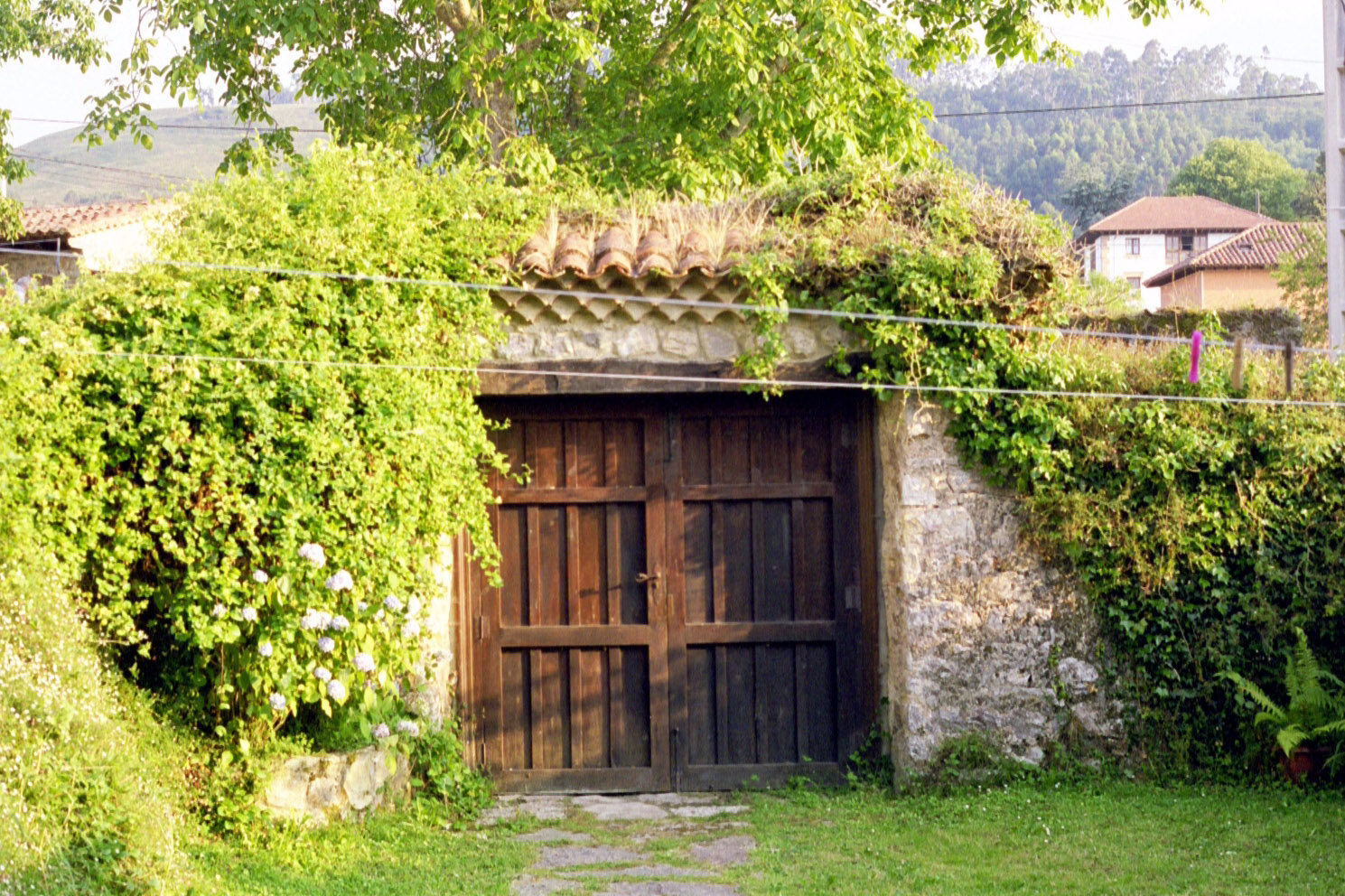
-
Puertas de Vidiago is quite small, consisting of about twenty or so buildings
and enough roosters to wake the whole province. To accommodate the ten
of us, we had arranged the rental of two adjacent houses with connecting
courtyards. The houses were quaint but in need of a good cleaning. I took
a few minutes to wander around the neighborhood, finding plum, fig, and
apple trees and the aforementioned roosters. It took only a few minutes
going in any direction before the limits of the town were reached.
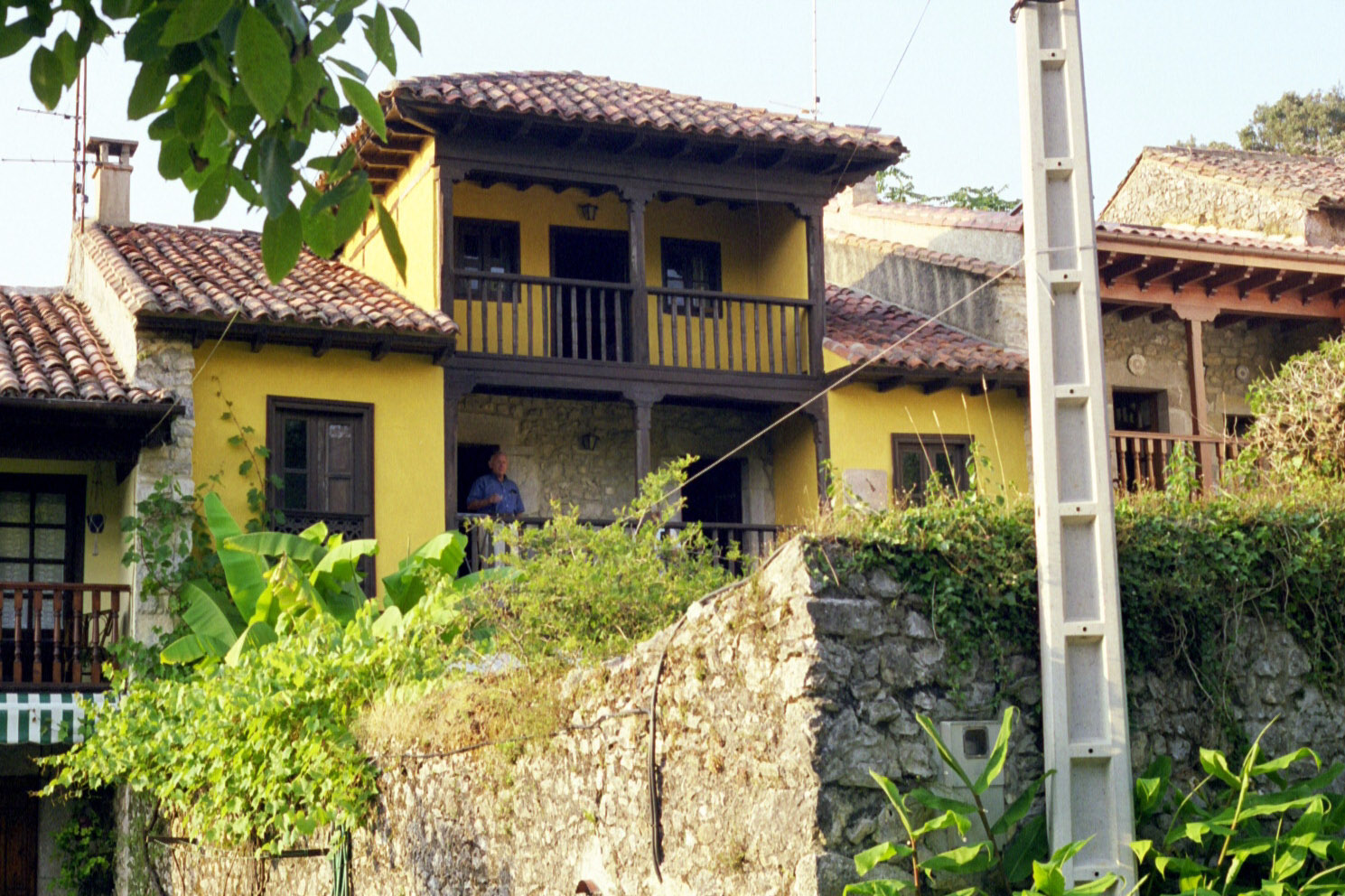
-
After allocating bedrooms, we ambled the fifty yards to dinner at the Sidería
Casa Poli, which, strangely enough, had been written up in the New
York Times earlier in the year. It was here that we learned the true
joy of tapas and Spanish wine, feasting for several hours on boar, venison,
jamón, potatoes with mayonnaise, garlic shrimp, and many others.
The walls of the room were stone which seemed to amplify our already boisterous
voices, but, no problem, the other diners were just as loud enjoying their
meal.
-
Friday, July 21:
-
Friday, we settled in. This involved some serious cleaning, which we should
not have had to do but which was necessary if we were going to use the
kitchen. There were ten of us, and spirits were high, so we managed in
a few hours to remove most of the dirt. This did not immediately help with
the flies (moscas), however, which were everywhere, and in great
numbers. So when it came time to make a run into the nearest real town
(Llanes, about 7 km away) to get food, we made sure to obtain fly
swatters and strips.
-
There was also time on Friday to find a way to the water, for the Bay of
Biscay was a short one mile walk on a country road past fields but no houses.
 The
coast itself consisted of cliffs, about 30 meters high, against which the
surf charged dramatically and into which ran dramatic gorges lushly overgrown
with plants.
The
coast itself consisted of cliffs, about 30 meters high, against which the
surf charged dramatically and into which ran dramatic gorges lushly overgrown
with plants. 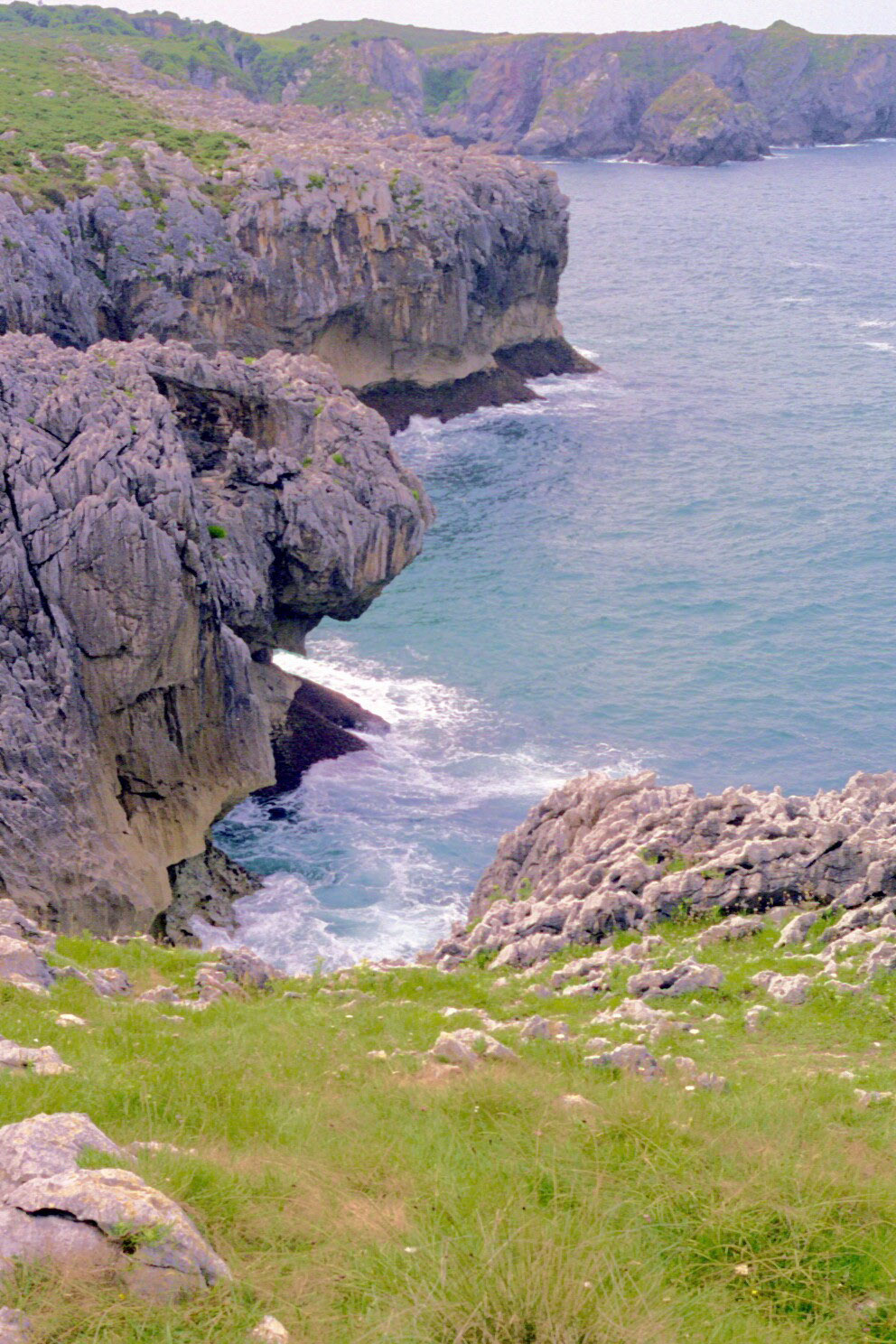 That
afternoon, the grocery crew returned with dates, figs, a variety of nuts,
olives, pickles, beer, and wine. So we relaxed, for the first of many pleasant
hours during our stay in Puertas de Vidiago, sitting at a picnic table
under a shaded awning in the courtyard swapping stories and discussing
politics.
That
afternoon, the grocery crew returned with dates, figs, a variety of nuts,
olives, pickles, beer, and wine. So we relaxed, for the first of many pleasant
hours during our stay in Puertas de Vidiago, sitting at a picnic table
under a shaded awning in the courtyard swapping stories and discussing
politics.
-
For dinner, we had neglected to make a reservation at Sidería
Casa Poli so we made a short drive down the highway (N634) to
another local restaurant, Restaurante El Flar, for an equally good
meal, albeit in an atmosphere with a television set showing game shows.
-
Saturday, July 22:
-
Saturday, we hiked from our houses in the opposite direction from the Bay.
Puertas de Vidiago is on the ancient pilgrimage route to Santiago de
Compostela. My elder daughter had hiked parts of this 450 km route
the previous summer, and she proudly showed us the seashell symbols that
marked our way that morning. Soon however, we turned inland and upward,
for we had heard that nearby there were some prehistoric rock drawings.
 And thirty minutes later, after climbing 400 meters over a kilometer or
so, we reached the top of a ridge which was commanded by a large rock (Peña-Tu)
dominating the view from all directions. On the side of the rock were numerous
drawings and a helpful park official handed us a brochure that interpreted
the drawings. We stayed for 45 minutes or so looking south toward the Picos
de Europa mountains or north to the Bay before hiking back to lunch
and a siesta.
And thirty minutes later, after climbing 400 meters over a kilometer or
so, we reached the top of a ridge which was commanded by a large rock (Peña-Tu)
dominating the view from all directions. On the side of the rock were numerous
drawings and a helpful park official handed us a brochure that interpreted
the drawings. We stayed for 45 minutes or so looking south toward the Picos
de Europa mountains or north to the Bay before hiking back to lunch
and a siesta.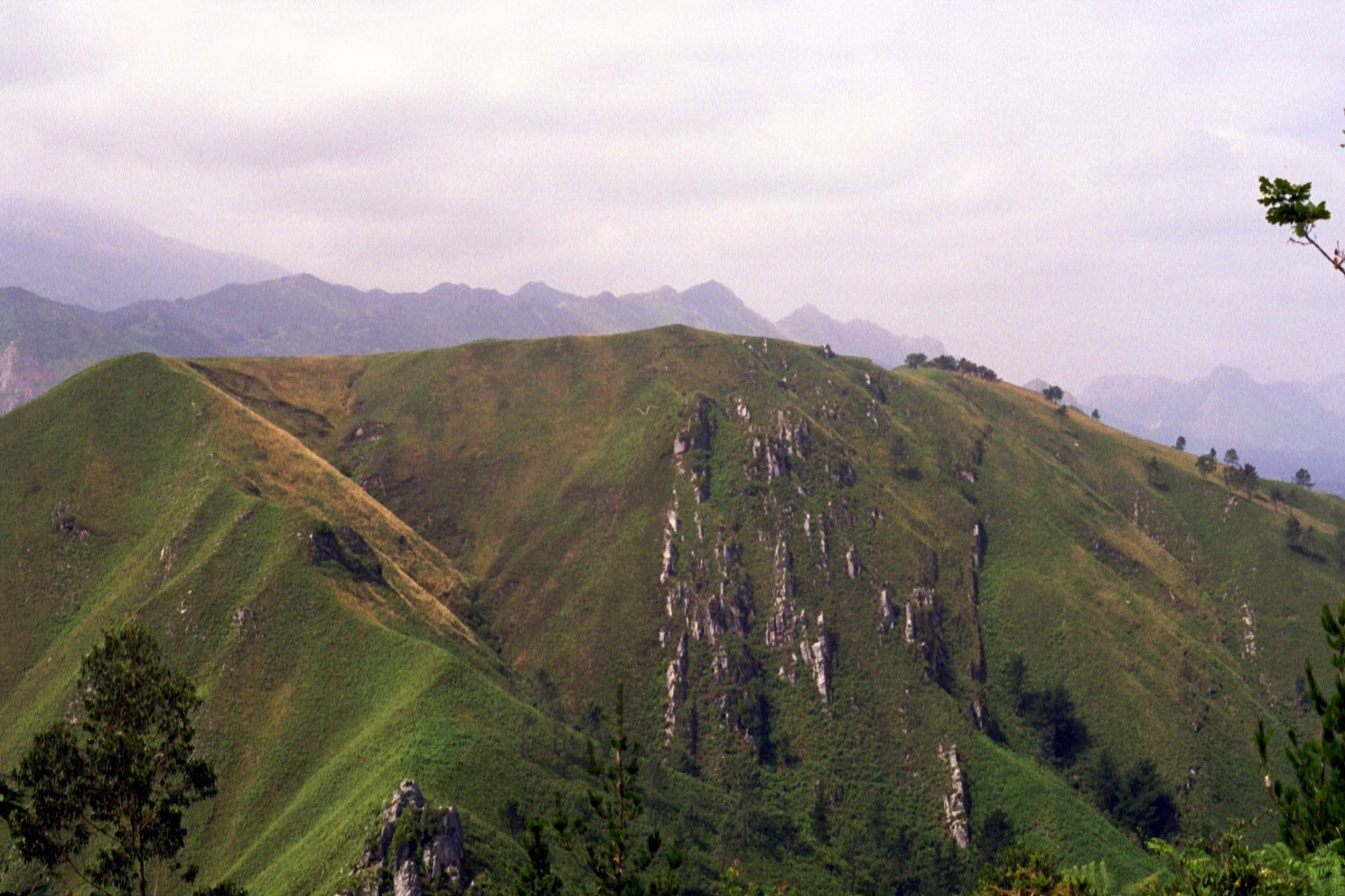
-
That night we cooked out. We had found an old grill at the house, and a
little cleaning made it usable. We bought steak and chicken at the grocery
store, added bread, salad, and wine, and enjoyed a fine Spanish evening.
Speaking of which, the weather throughout our trip was perfect, with temperatures
around 30°C during the day, occasional clouds, but nary a raindrop.

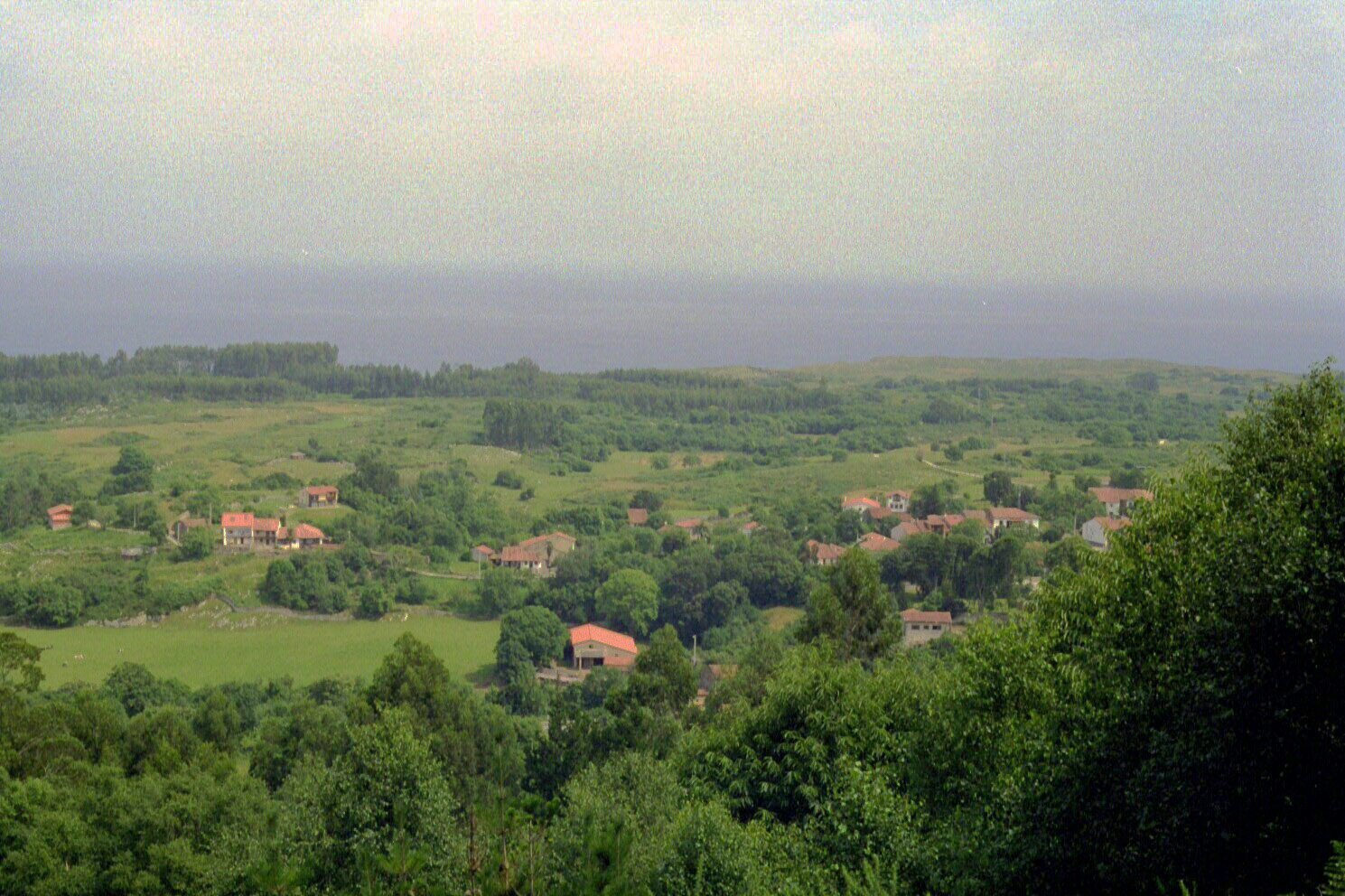
-
Sunday, July 23
-
The town of Llanes, about 7 km west of Puertas de Vidiago was having
a festival while we were there. Sunday, we slept in, tried to figure out
how to use the world's smallest washing machine, and went to the festival.
It was a challenge to negotiate the narrow, crowded streets and find a
parking place. Once accomplished, we walked the 800 or so meters to a seafood
restaurant on the water and had another fine meal, including the
local sardines, eaten head and all. After the meal, we walked through the
festival before returning to Puertas de Vidiago.
-
Monday, July 24
-
Puertas de Vidiago sits just north of the largest national park in Europe,
the Parque Nacional de Los Picos de Europa. Evidently the Picos
de Europa mountains were the first sight of mainland Europe that sailors
could see upon returning from the new world. And the primary reason for
choosing to visit Asturias was so we could explore them. On Monday we set
off to visit the park, aiming for Fuente Dé where, our guidebooks
promised, a cable car provided dramatic views and 1000m head start on the
elevation gain.

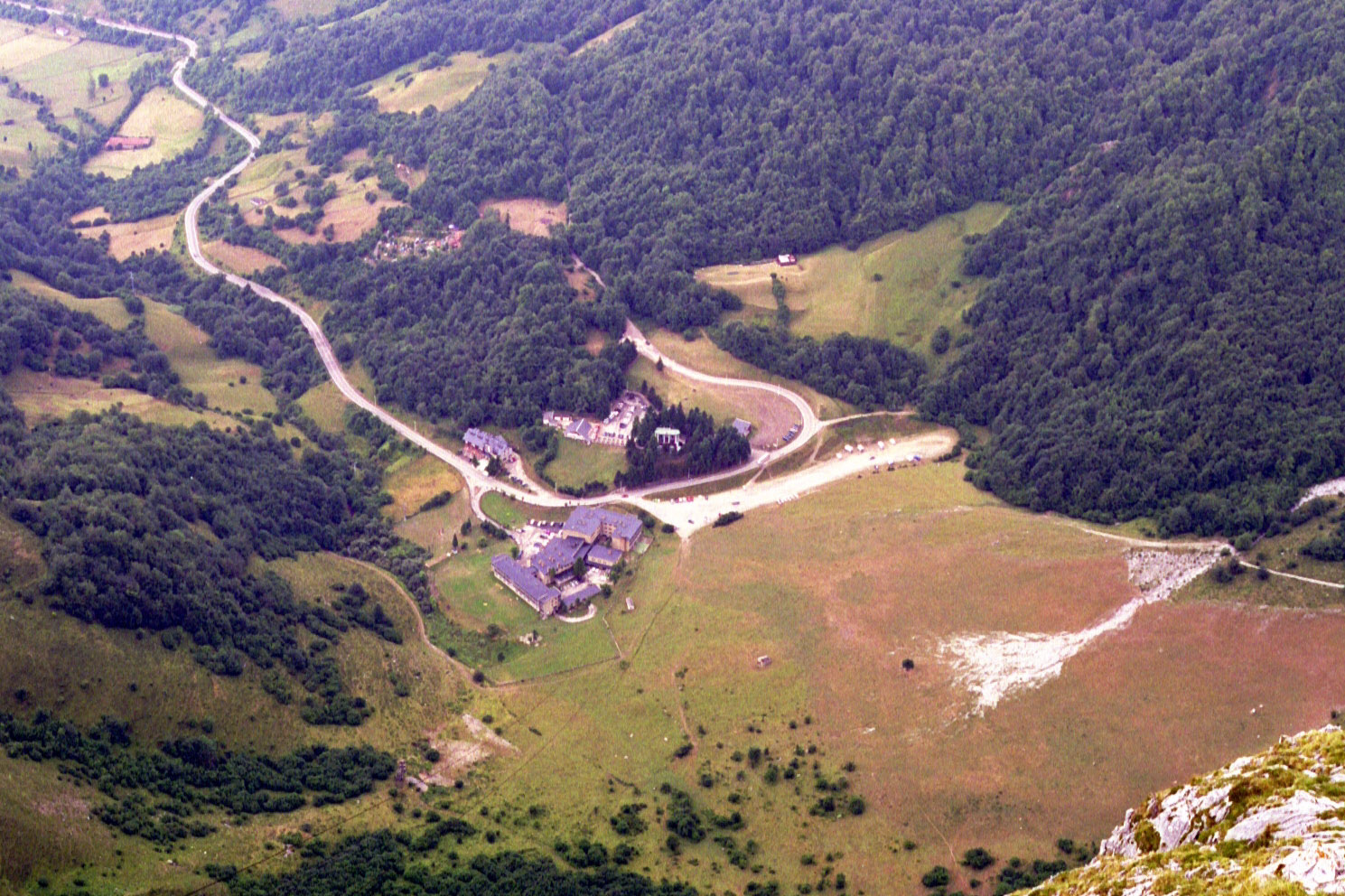
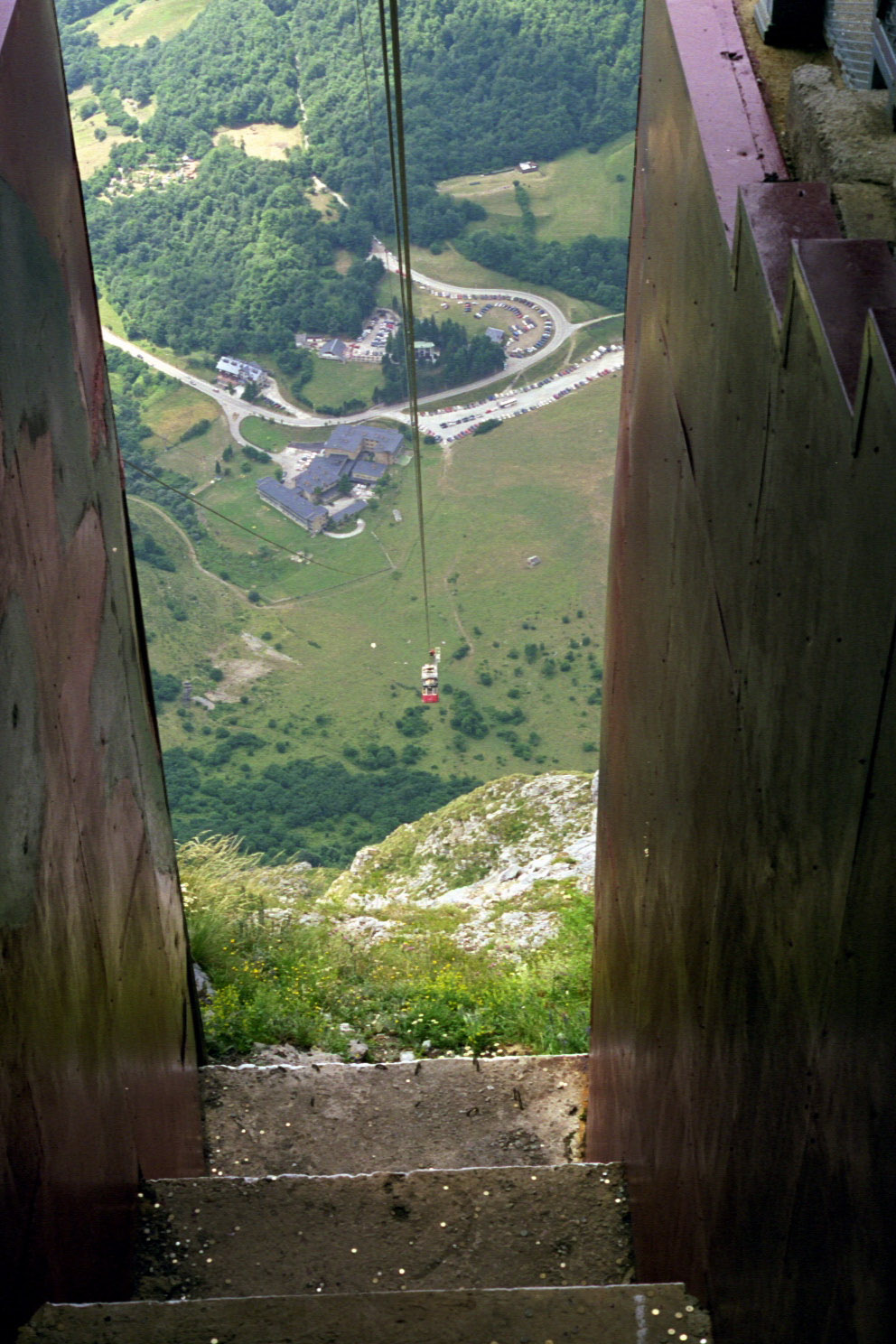
-
Visiting the park required a drive of about an hour, but afforded us a
stop in Panes where market day allowed us to purchase picnic supplies and
a local cafe offered churros, fried and sweetened dough, and hot chocolate.
-
The views from the cable car were indeed dramatic, and the hike, although
a bit windswept, provided vistas of the austere mountains.
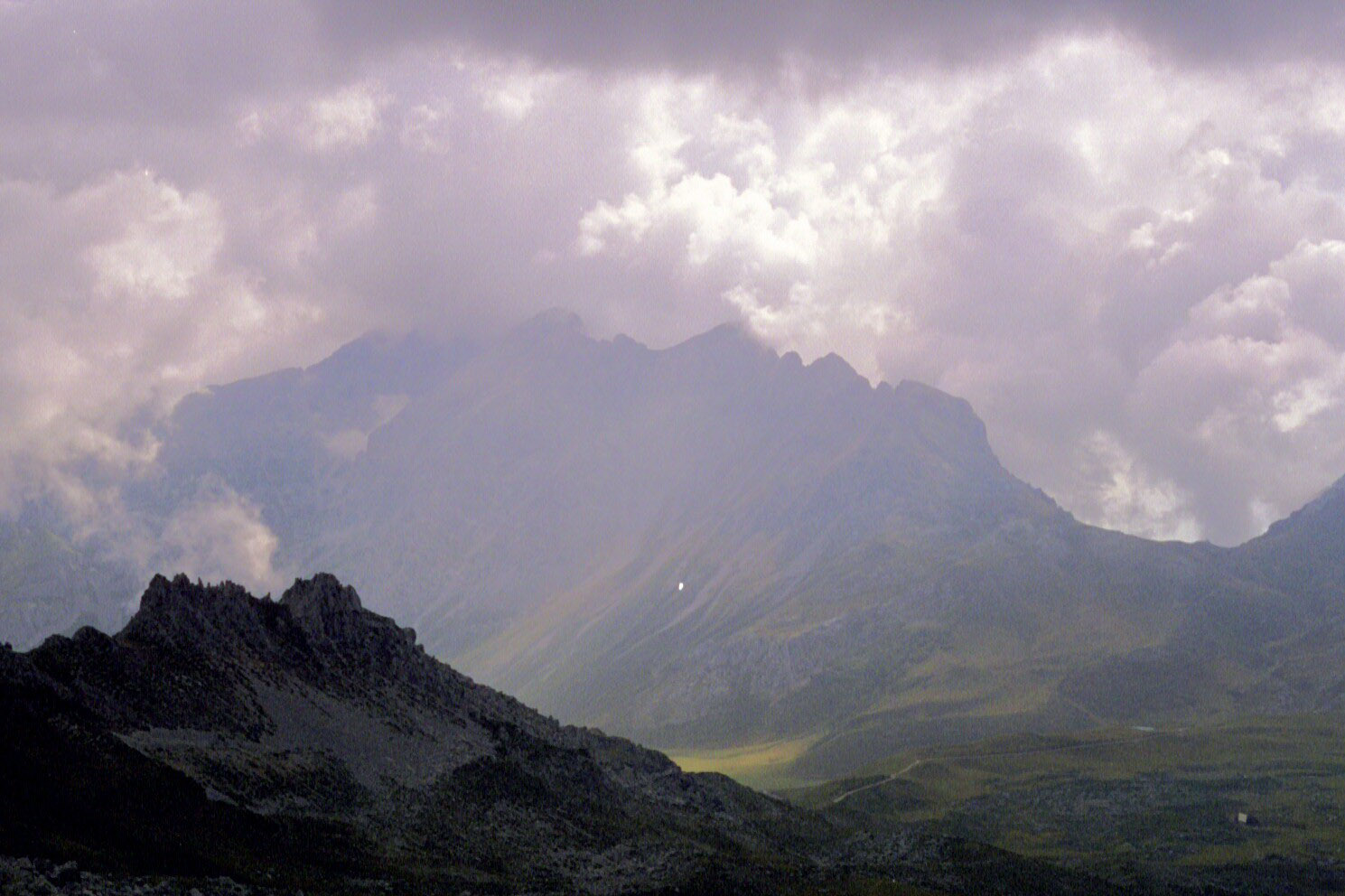
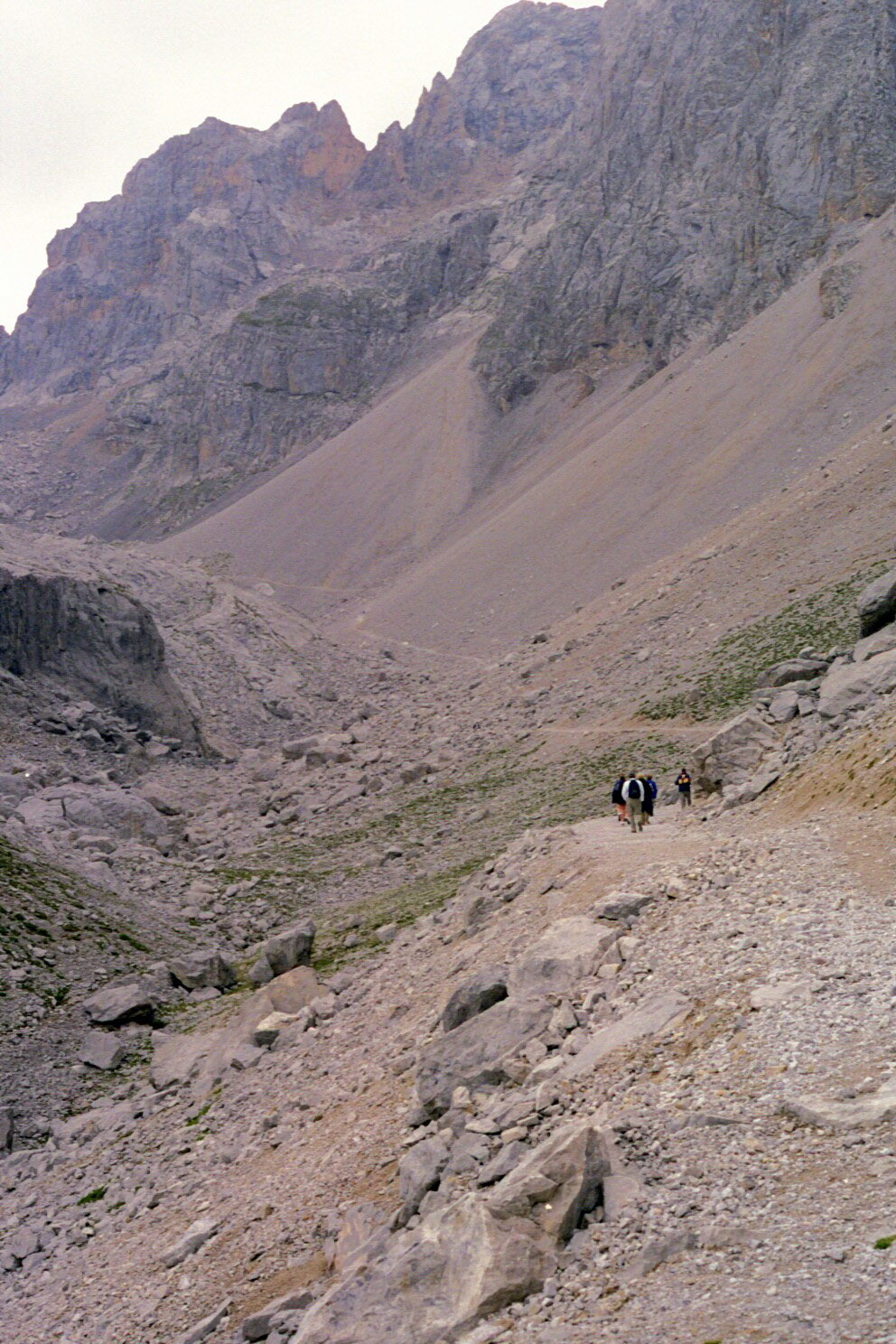
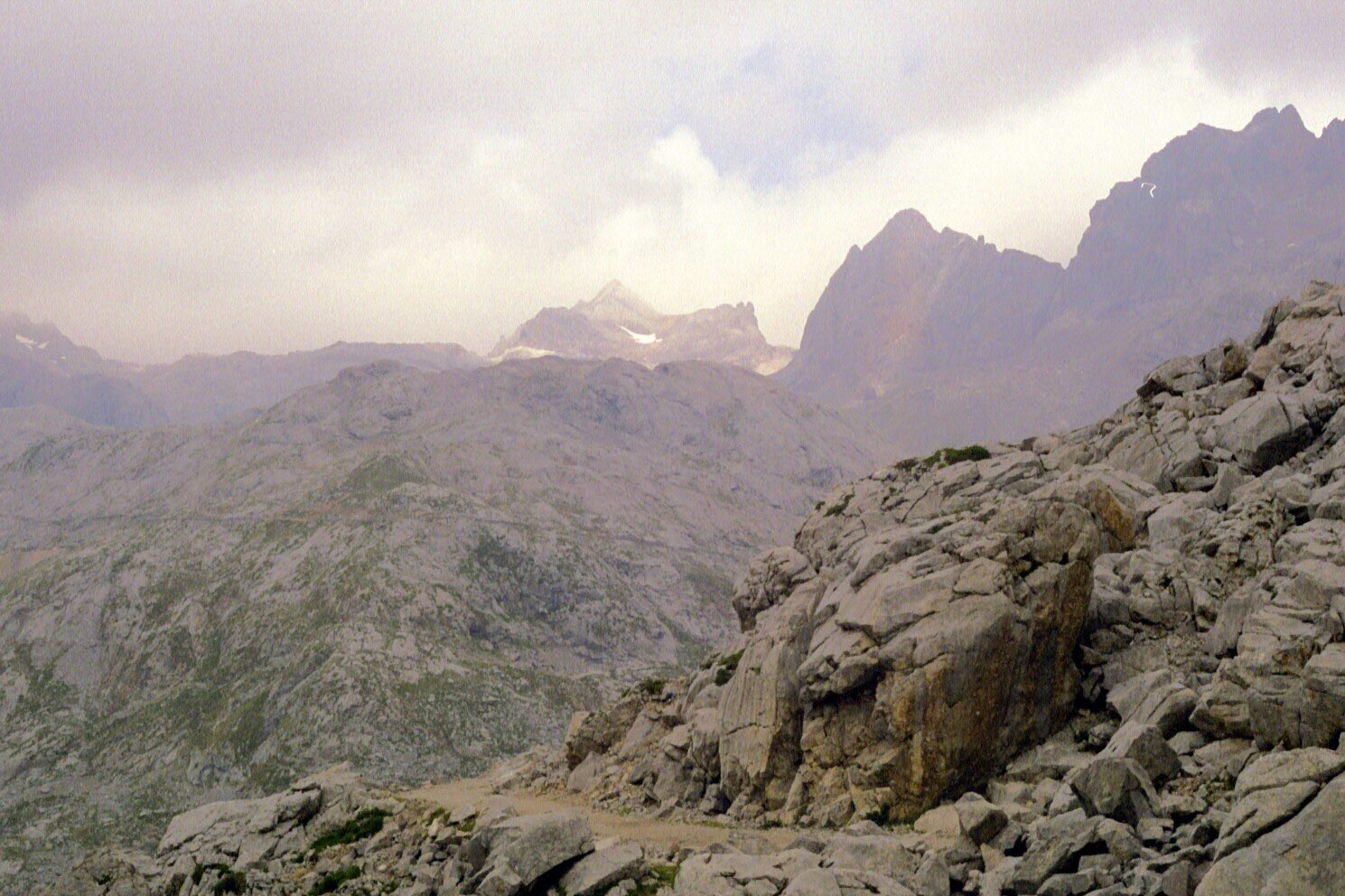 After
the hike and the cable trip down, we enjoyed our picnic on tables at the
less windy bottom cable terminus. The return trip featured a brief stoppage
as a herd of horses trotted its way up the road.
After
the hike and the cable trip down, we enjoyed our picnic on tables at the
less windy bottom cable terminus. The return trip featured a brief stoppage
as a herd of horses trotted its way up the road. Returning to Puertas de Vidiago, we revisited Restaurante El Flar
for another hearty dinner.
Returning to Puertas de Vidiago, we revisited Restaurante El Flar
for another hearty dinner.
-
Tuesday, July 25
-
Tuesday, we decided, would be our own feast day, and preparations took
most of the day. We would grill salmon, add garlic peppers and salad, bread
and wine.Throughout our stay, the local produce would prove exceptionally
good. I was particularly impressed by the peaches, which put those Georgia
is famous for to shame.
-
Wednesday, July 26
-
Our final day in Asturias would feature another visit to the park. This
time, we approached from the east, again stopping to buy our picnic supplies
and breakfast in Potes. We had chosen to visit Los Lagos, which required
about an hour's drive, the last part of which was a narrow, winding road,
liberally supplied with steep drop-offs and wandering goats. Occasional
encounters with approaching trucks and buses required short stops.
-
This side of the park was greener, filled with cows,
 horses, goats, sheep,
horses, goats, sheep, and herding dogs, but also had great views.
and herding dogs, but also had great views.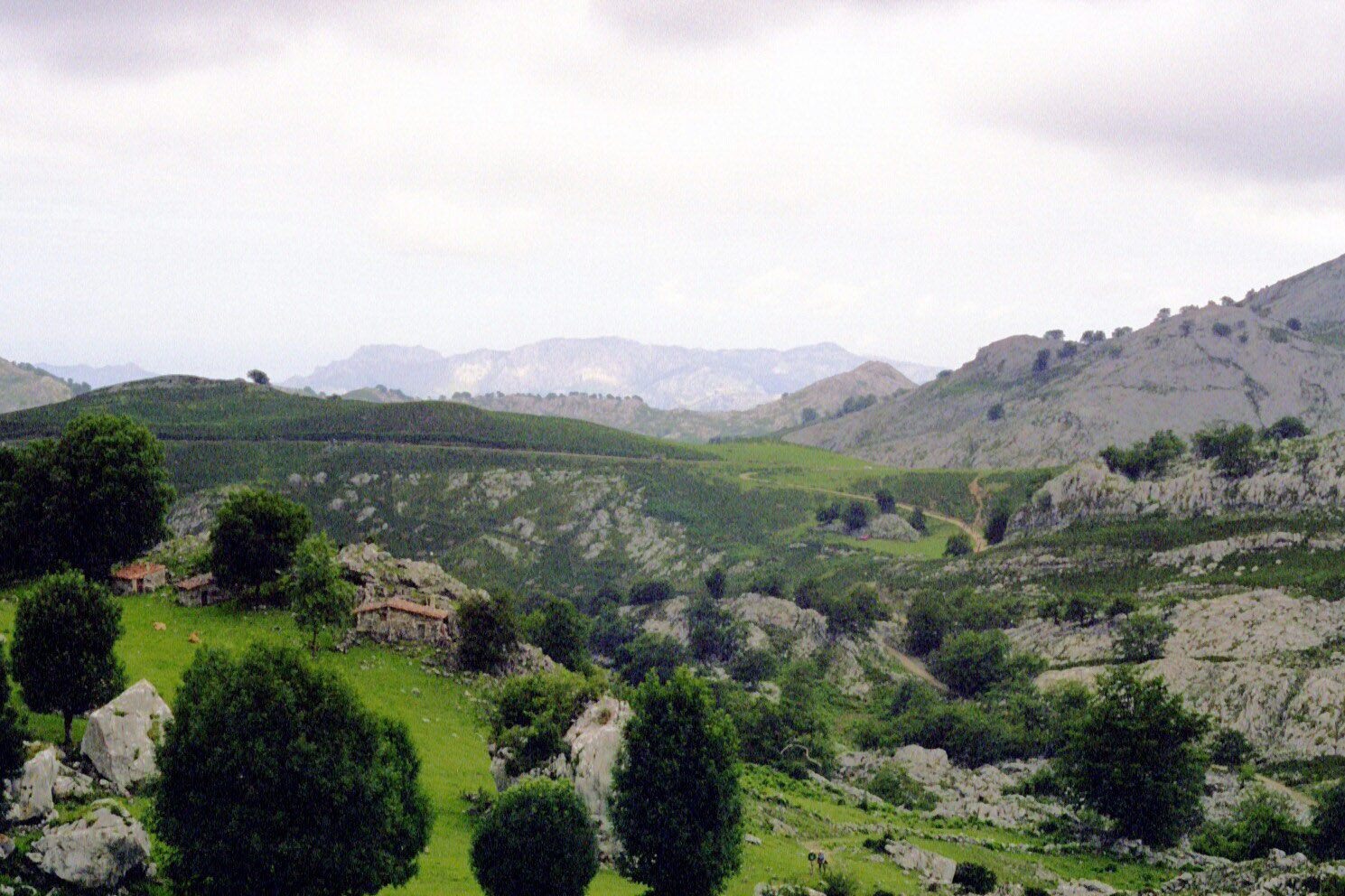
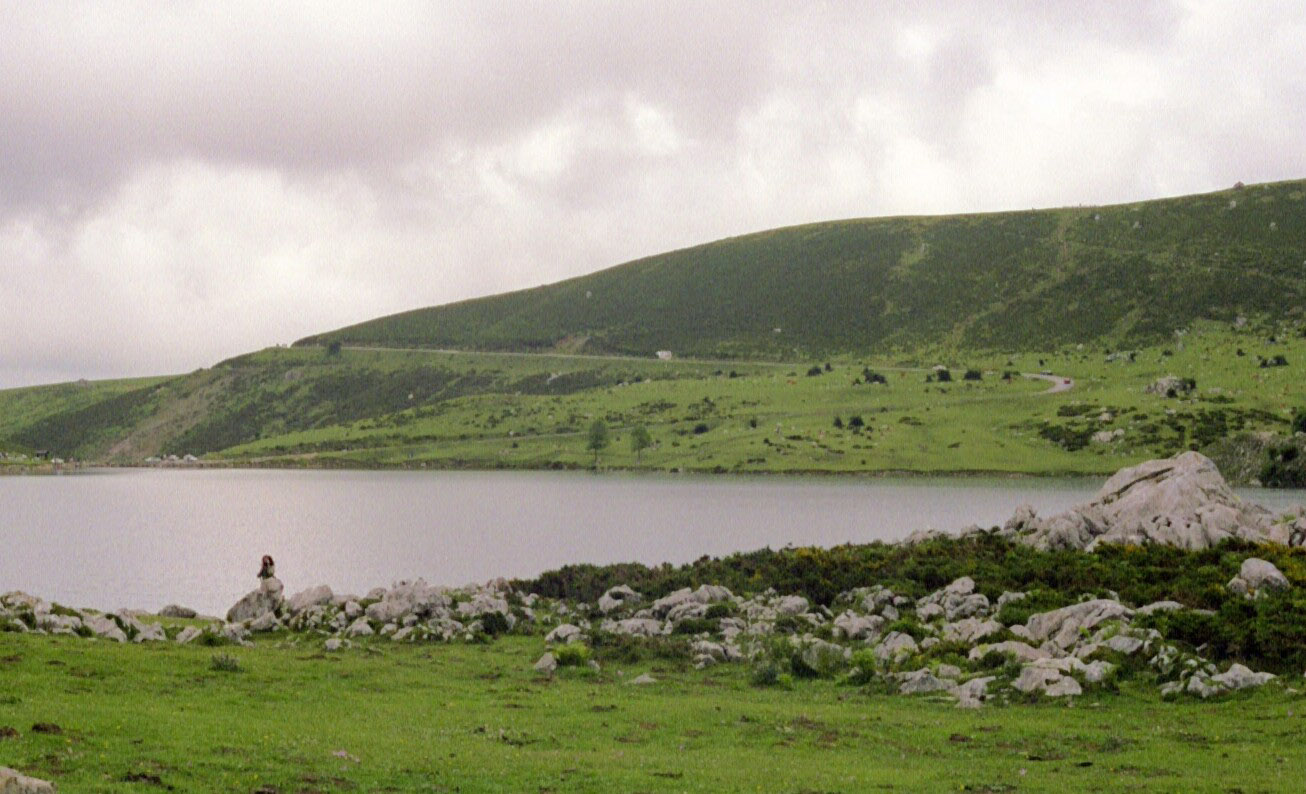
 We
picnicked and hiked back out before returning to Puertas de Vidiago and
a final dinner at
Sidería Casa Poli where we had thoughtfully
reserved a table.
We
picnicked and hiked back out before returning to Puertas de Vidiago and
a final dinner at
Sidería Casa Poli where we had thoughtfully
reserved a table.
-
Thursday, July 27
-
On Thursday, we vacated the house by 10:00, one couple proceeding to explore
the Basque country, one driving southward, and the other six, including
my family, heading for Barcelona. We drove our rental car to the Santander
airport and took the 2:50 flight to Barcelona, enjoying nice views of the
Pyrenees and Mediterranean from the airplane window. A taxi took us to
our hotel, the Gran Hotel Barcino, ideally situated on the south
edge of the
Barri Gòtic, the oldest section of Barcelona.
The rooms were quite nice, but I made the mistake of not asking for a room
off of the street, and the street we were on was noisy at all hours. The
hotel was also conveniently near the Metro and restaurants. We spent the
remainder of the afternoon strolling the narrow streets of the old town
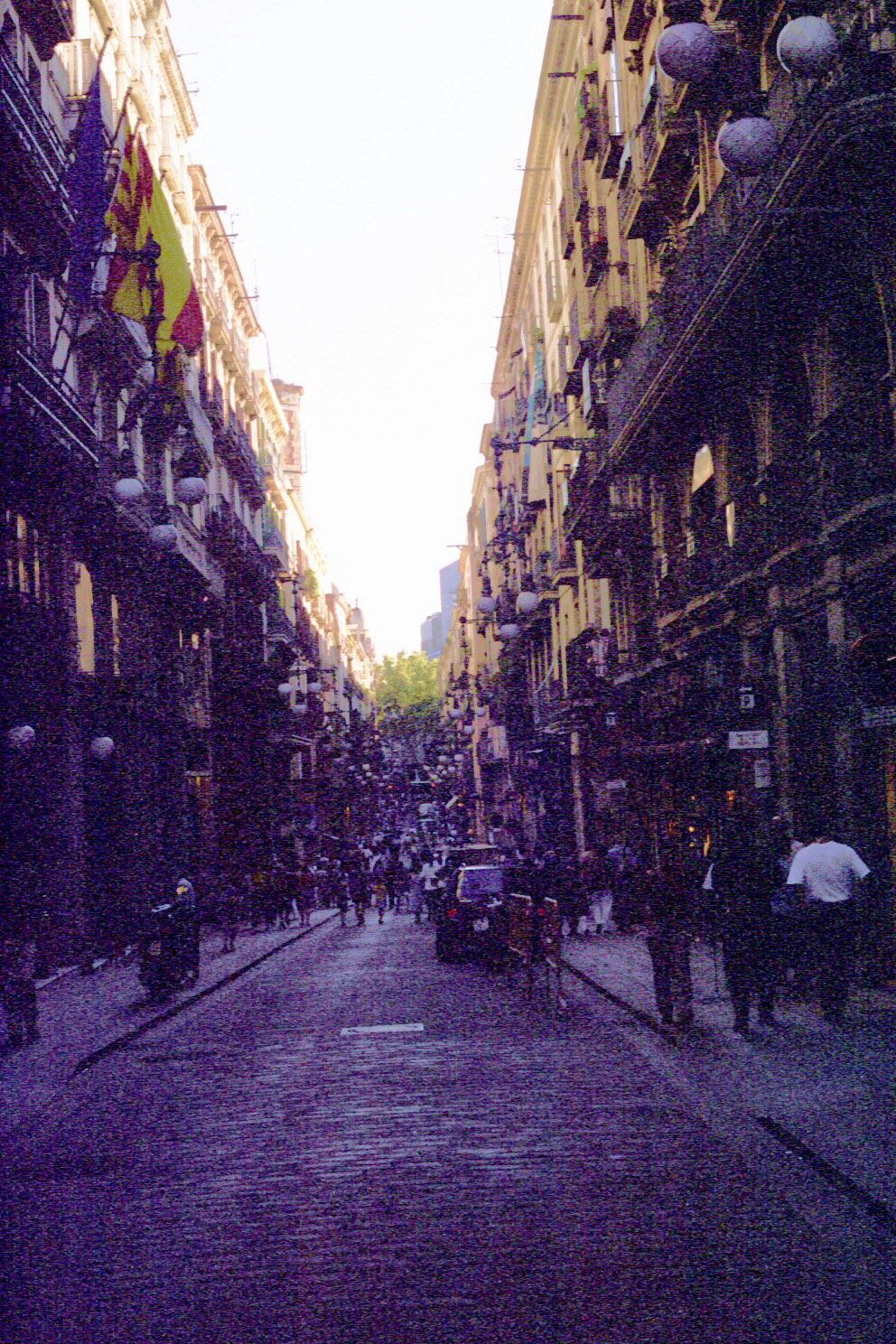 including a visit to the Gothic cathedral.
including a visit to the Gothic cathedral.
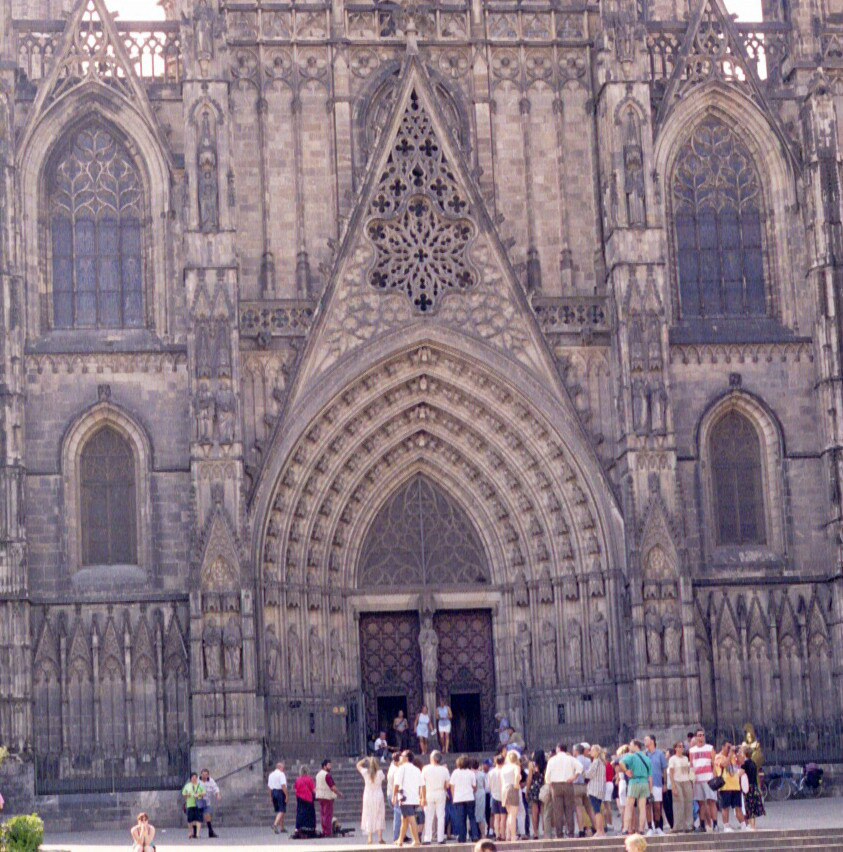
 We then grabbed a quick bite to eat in a sandwich shop before returning
to the hotel to catch up on some much needed sleep.
We then grabbed a quick bite to eat in a sandwich shop before returning
to the hotel to catch up on some much needed sleep.
-
Friday, July 28
-
We had been advised that a nice way to get an introduction to Barcelona
was to take the Turistic tour bus. The hotel desk pointed us to the bus
stop a block away. However, there was some construction there so we decided
to continue walking to the Plaça de Catalunya. In fact, the
tour bus had two routes, northern and southern, and one of the common stops
was at the Plaça. The tour was such that you could get off
the bus at any stop, visit a site, and catch a later bus. Moreover, the
bus tickets included a discount book for many of the stops that we visited.
Because the buses ran at 10-15 minute intervals, this allowed us a flexible
way to visit several sites which would be inconvenient otherwise.
-
The buildings in Barcelona have been heavily influenced by the architect
Antoni Gaudí i Cornet (Gaudí). The bus drove us by his Casa
Batlló, a home, (unfortunately, being restored), the Casa
Milà "la Pedrera" (an apartment complex),
 the unfinished Sagrada Família cathedral,
the unfinished Sagrada Família cathedral,
 and the
Parc Güell (a city park).
and the
Parc Güell (a city park).
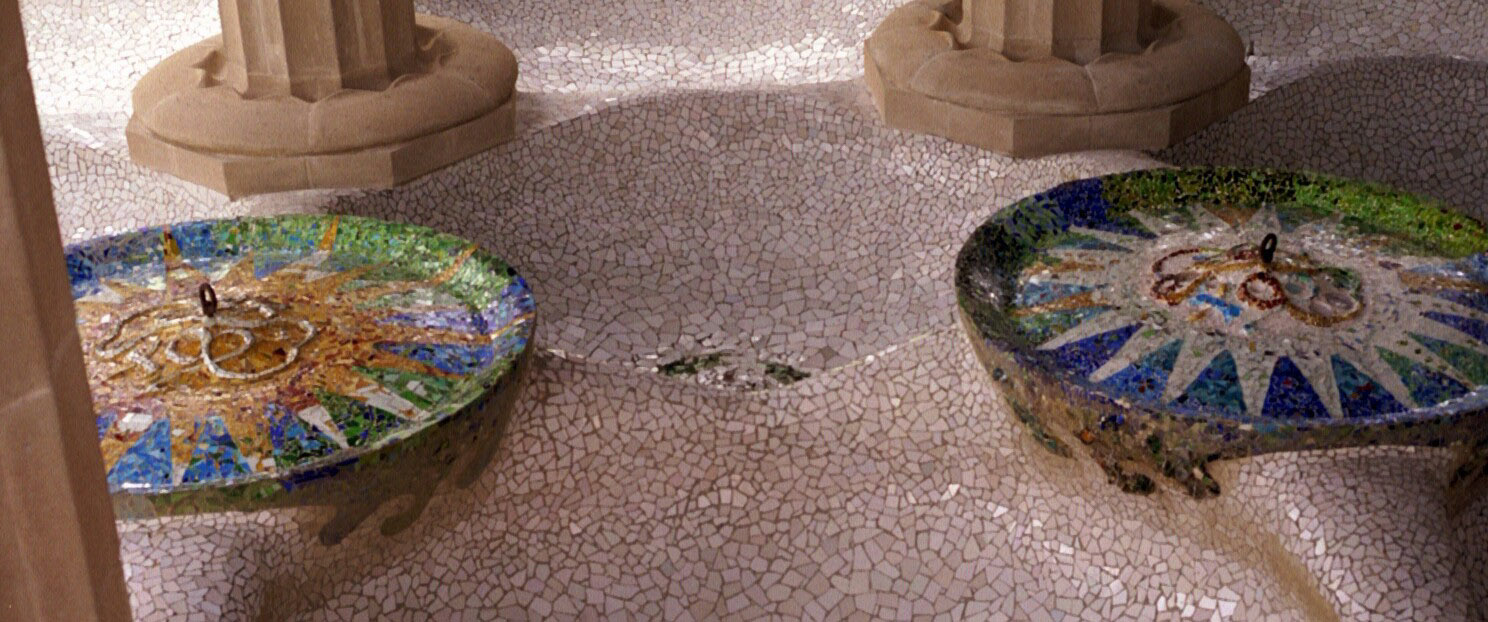
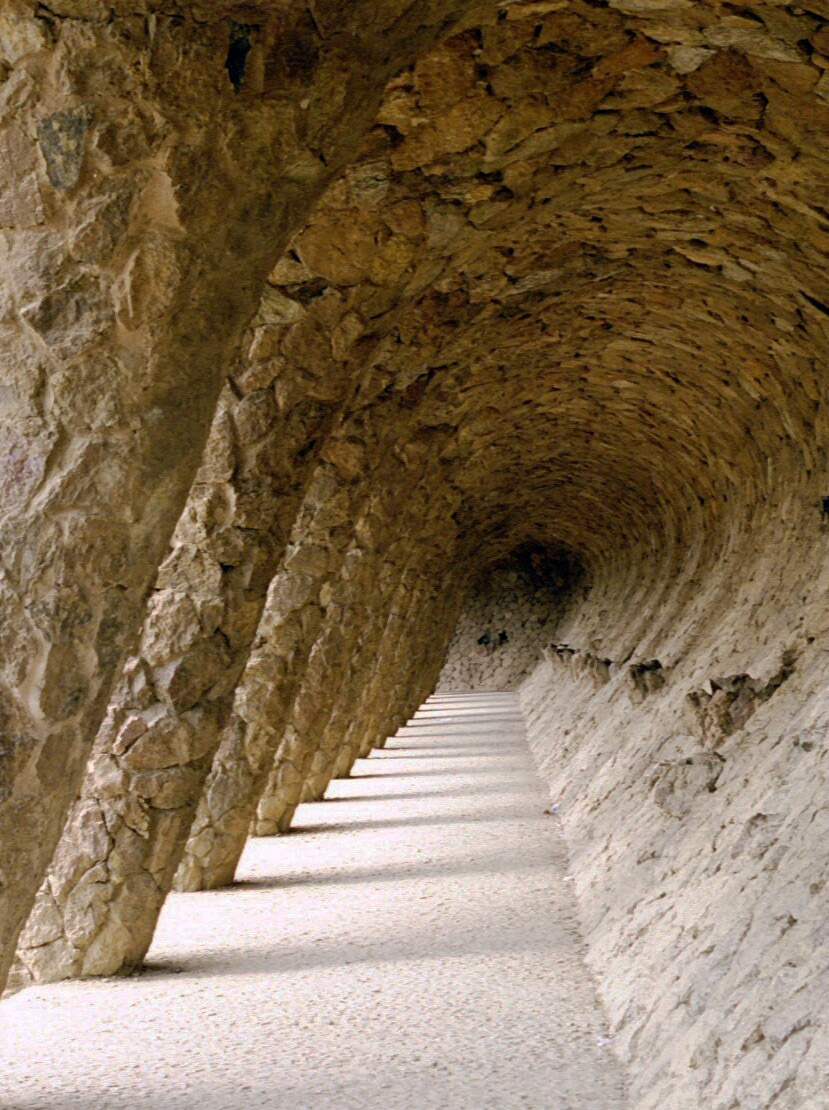



We stopped at the latter two.
-
The tour itself had about a dozen stops, lasting 1:50 minutes, and returning
us to the Plaça de Catalunya just in time to get to our recommended
lunch site, the Hostal de Rita on Carrer D'Aragó, before
the crowds. The restaurant turned out to provide a great meal and a great
value. After lunch, we visited a 24 hour internet site so my daughters
could catch up on their e-mail, before returning to the Plaça
de Catalunya for the southern tour. Our tickets included both tours
on the same day.
-
The southern tour included Montjuïc, a park on a hill overlooking
the town, the port area, and the Parc de la Ciutadella, another
city park, this one including the Barcelona zoo. When the tour returned
us to the Plaça de Catalunya, we visited the Tourist Information
Center located there and determined that Friday evening there would be
an equestrian display on Montjuïc. Instead of reusing the tour
bus, we took the Metro to the
Plaça d'Espanya, intending
to walk to the show. However, there was a tour bus there about to leave,
so we saved some climbing by taking it for one stop.
-
The equestrian show was quite impressive, featuring horses and riders from
the municipal police. Afterwards, we followed the crowds past the Palau
Nacional to the Plaça de les Cascades, a series of descending
steps leading to the Font Màgica, a truly magic fountain
and one of the high points of our visit. Here to the accompaniment of classical
music, the fountain erupts with water colored by lights. Thousands of people
joined us in enjoying the show and an ice cream snack from a nearby kiosk.
Highly recommended. We returned to our hotel on the Metro after a long
but rewarding day.
-
Saturday, July 29
-
On Saturday, we visited the Palau de la Música Catalana,
Barcelona's music hall, a short walk from our hotel. We bought tickets
in the nearby gift shop but had to wait an hour for a tour to be conducted
in English. But the tour was well worth the wait. Not only was the tour
guide engaging and well informed, but the building itself is extraordinary.
A definite
don't miss.
-
After the Palau de la Música Catalana, we strolled across
the old town to Museu de Art Contemporani, just west of La Rambla.
This is a collection of twentieth century art, and not specifically Catalan,
at that. In retrospect, I would probably choose the Museu Nacional d'Art
de Catalunya on Montjuic. The Museu d'Art Contemporani has no
cafe, but an adjacent cafe, Pla del Angels, on the plaza, was an
unexpected gem, with inexpensive but excellent food and a nice atmosphere.
-
After lunch, while the rest of the family shopped and napped, I visited
the Museu d'Història de la Ciutat, Barcelona's history museum.
By far, the most extensive and interesting aspect of the Museu
are
the extensive Roman ruins under it. These include a winery, a laundry and
dye shop, a sea-food sauce factory, a public area, and the early stages
of the Christian church. Viewing the ruins, my appreciation of the accomplishments
of the Romans was extended considerably.
-
For dinner, I had a recommendation to visit Hoffman on Carrer
de la Argentaria, near our hotel. However, my telephone calls to make
a reservation went unanswered and my side trip to visit in person were
met by a metal gate, typical of stores in the old city during siesta. Instead,
based on a recommendation from the hotel, we ate at the nearby Senyor
Parellada, a somewhat pricey but high quality restaurant.
-
Sunday, July 30
-
We also had a recommendation to take Sunday brunch at the Arts Hotel
on the waterfront. Fortunately, I called ahead. Unfortunately, the restaurant
was being refurbished, and we made do with pastries and juice in a shop
near the hotel. We had determined that my wife and daughters would use
Sunday for shopping while I would use it for strolling. They were disappointed,
however, to learn that most of the stores were either closed for the day,
or closed while they were there. They did, however, catch a glimpse of
the
sardona,
the national dance of Catalonia, being danced in front
of the Cathedral in the Barri Gòtic.
-
My stroll, however, came off well. I started at the Plaça de
Catalunya in order to walk the length of La Rambla, the tree
lined avenue that best captures the energy of Barcelona. There were shops,
mimes, musicians, and lots of people, just strolling. Don't miss La
Rambla if you want to truly experience Barcelona.
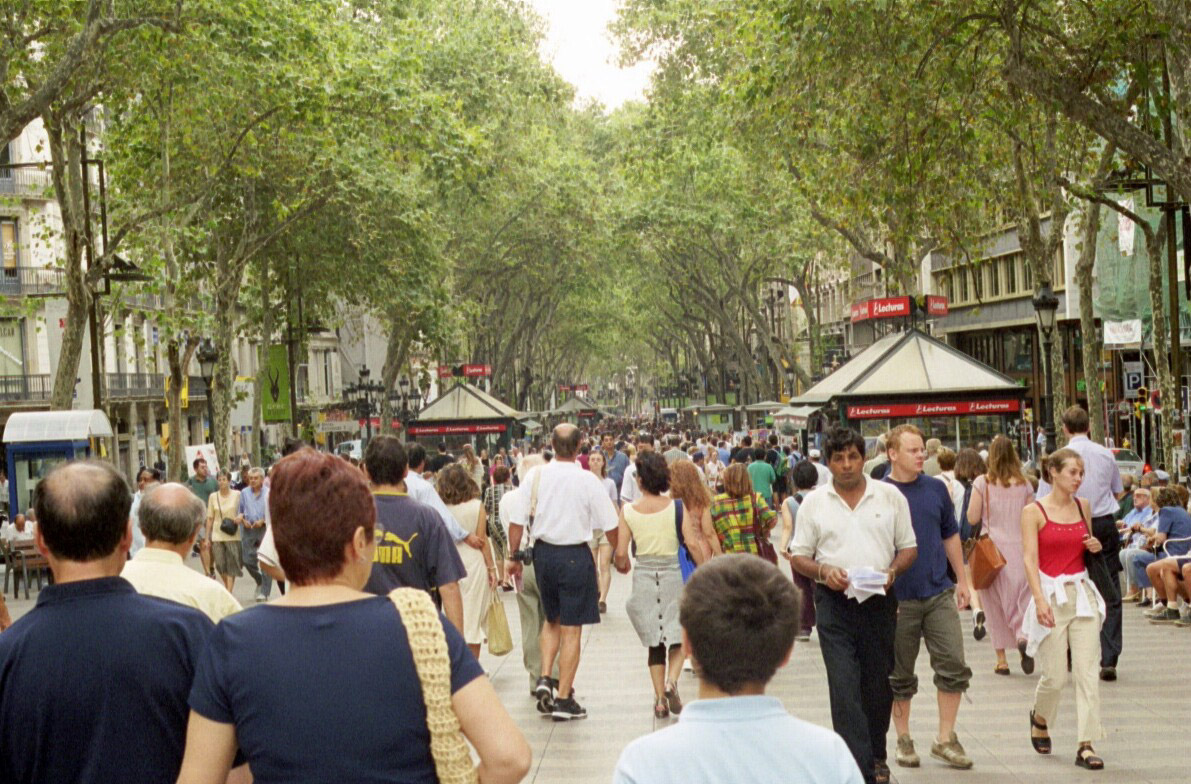
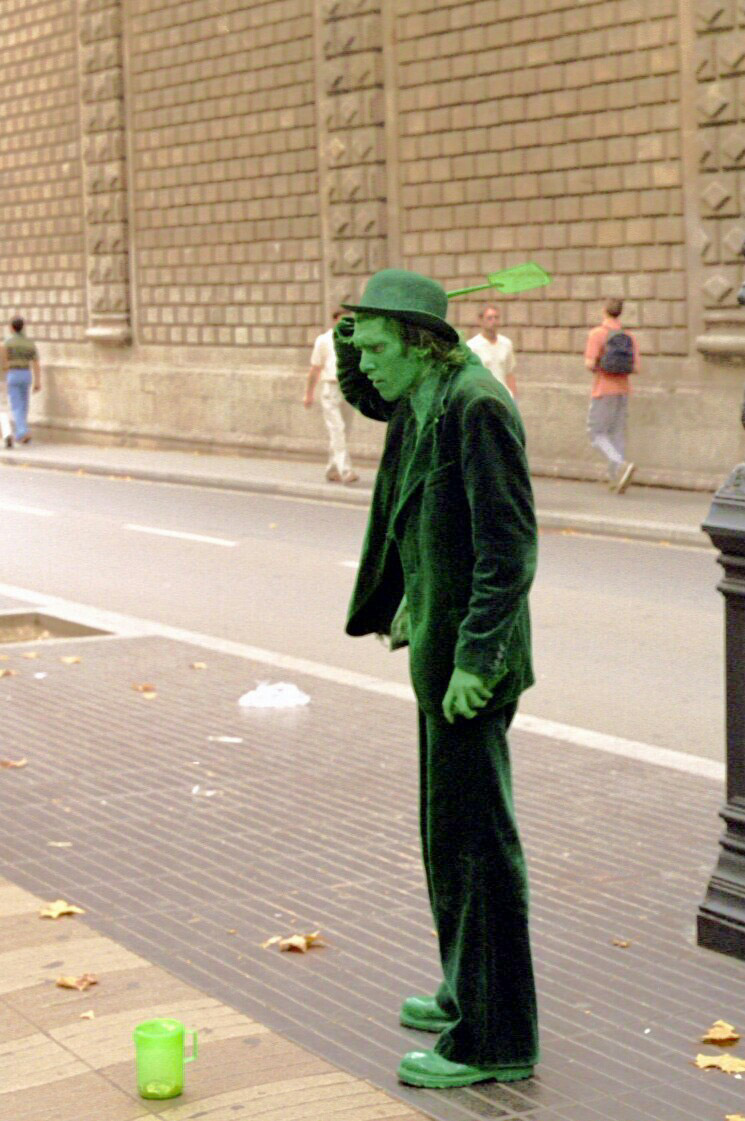
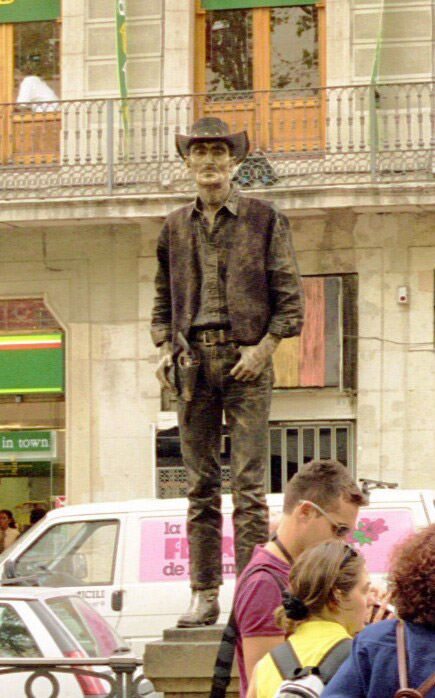
-
La Rambla ends at the the Monument a Colom, a towering statue
to Columbus at the waterfront.
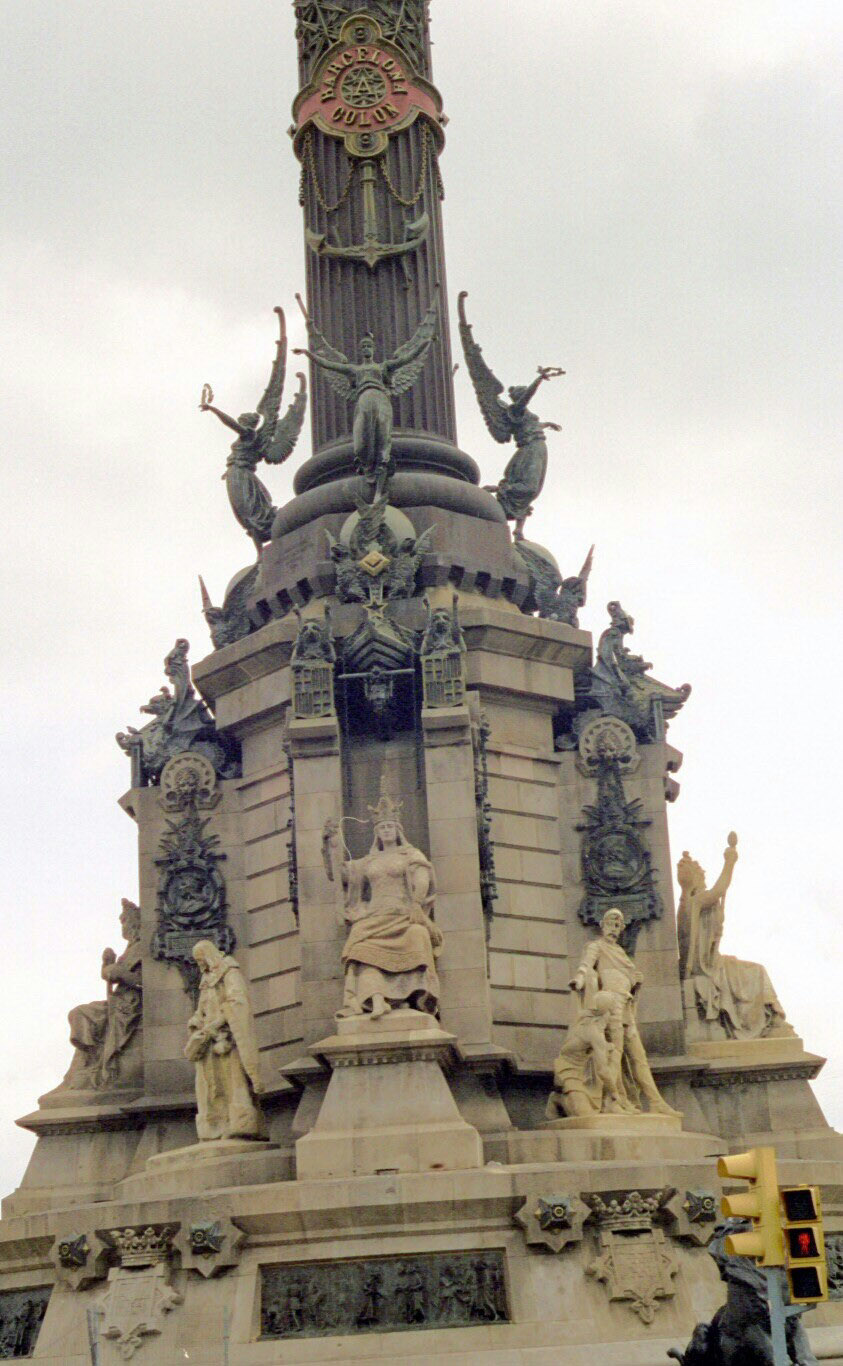 From there, I followed the crowd across a pedestrian bridge to Maremagnum,
a mall on a (presumably) artificial island called Port Vell.
From there, I followed the crowd across a pedestrian bridge to Maremagnum,
a mall on a (presumably) artificial island called Port Vell. The island also features the aquarium and an IMAX cinema. After I passed
through Maremagnum, I continued to parallel the water northeastward
until I came to the Arts Hotel on the beach just before the
Parc Port Olímpic. The hotel features an impressive, bronze
colored, abstract sculpture leading to the beach.
The island also features the aquarium and an IMAX cinema. After I passed
through Maremagnum, I continued to parallel the water northeastward
until I came to the Arts Hotel on the beach just before the
Parc Port Olímpic. The hotel features an impressive, bronze
colored, abstract sculpture leading to the beach.
-
Turning inland for several blocks and then back southwestward, I came to
Parc
de la Ciutadella, a city park which includes Barcelona's zoo.
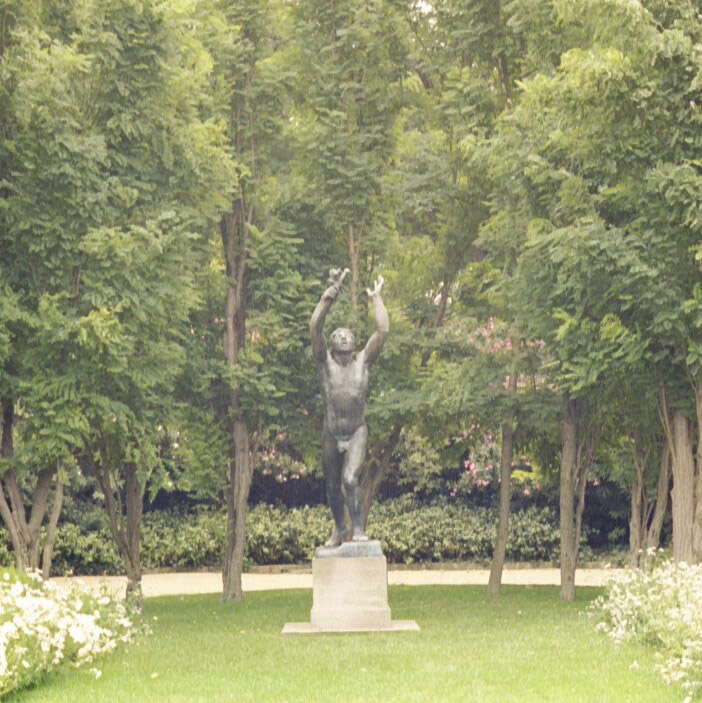
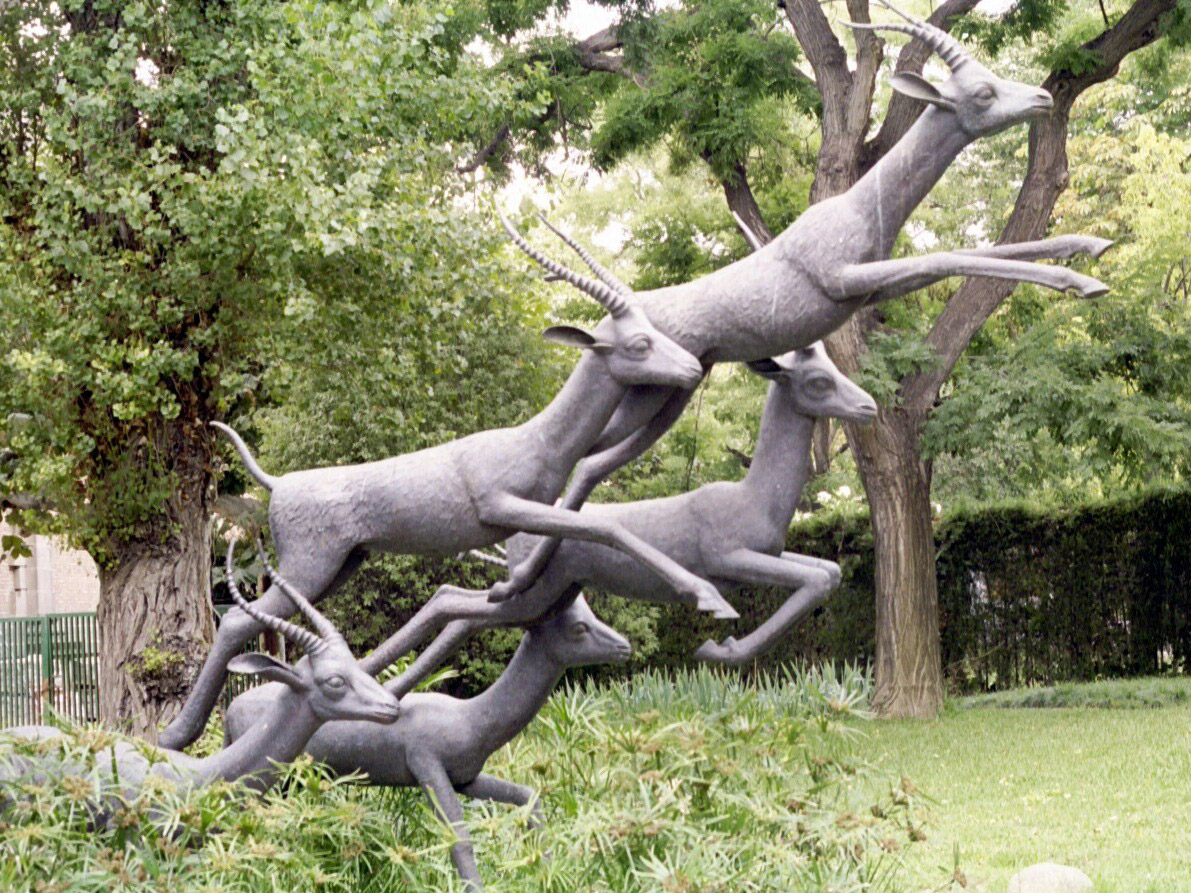 I spent the remainder of the afternoon wandering the park, stopping to
sit on benches, reading, and people watching.
I spent the remainder of the afternoon wandering the park, stopping to
sit on benches, reading, and people watching.  From
the park, a brief walk westward brought me back to the old city and its
narrow streets.
From
the park, a brief walk westward brought me back to the old city and its
narrow streets.
-
Rejoining my family for the evening meal, we tried another recommended
restaurant, Monchos in Maremagnum. It was my intent to experience
some local fish cooked a la Sal, baked in a mound of salt. There
were several problems, however. The first was finding the restaurant. There
were no directories in the mall. In fact, we couldn't see a restaurant
with that name at all. My daughter, however, did see two employees taking
a break wearing aprons with the restaurant's name. We even tried asking,
but experienced our one communications failure on our whole trip. It was
only then, when we were deciding what alternatives we had, that my daughter
noticed the word Moncho's embedded in small letters in the sign
for a restaurant with the name
El Chipiron. The second problem was
that the food, although tasty, was overpriced. In fact, this turned out
to be our most expensive meal on the entire trip, and certainly not our
best.
-
Monday, July 31
-
For our last day in Spain, we chose to take a trip up the Costa Brava,
the
so-called wild coast of the Mediterranean, northeast of Barcelona. We took
the Metro to the Estació del Nord bus station, where we purchased
tickets to Lloret de Mar on the Sarfa bus
line, a one hour ride up the coast. The part of the town we saw was
strictly for tourists, with gift shops and restaurants girding a lengthy
artificial beach, filled that day with sun worshippers, including my daughters.
 Visitors should be aware that occasional toplessness occurs.
Visitors should be aware that occasional toplessness occurs.
-
While my daughters "laid out", my wife and I walked the boardwalk to a
walled castle on a hill overlooking the beach and the Mediterranean.
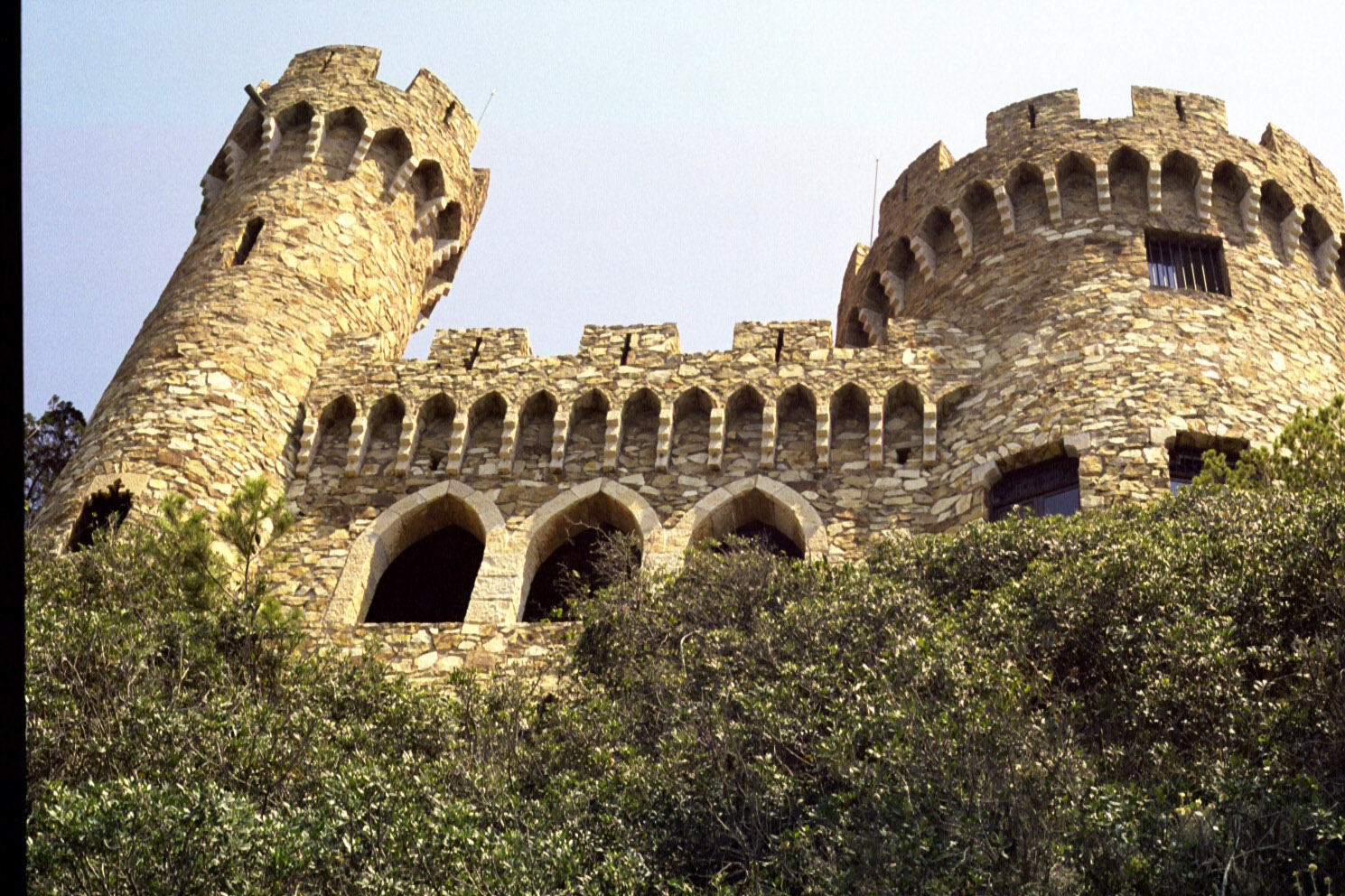 After walking back, we met up with the girls and had lunch in a sidewalk
cafe overlooking the water. A short walk brought us back to the bus station
for our return to Barcelona. We had dinner at a small restaurant,
Cafe
La Montse I , also on Carrer de la Argentaria near the hotel,
in retrospect a poor choice for our last evening in Spain.
After walking back, we met up with the girls and had lunch in a sidewalk
cafe overlooking the water. A short walk brought us back to the bus station
for our return to Barcelona. We had dinner at a small restaurant,
Cafe
La Montse I , also on Carrer de la Argentaria near the hotel,
in retrospect a poor choice for our last evening in Spain.
-
Tuesday, August 1
-
Our return to Atlanta was lengthy but uneventful, other than a long delay
in customs at Atlanta. A taxi took us to our home, welcome after our lengthy
but enjoyable ramble through Spain.



 It
was during this walk that we had the only encounter during our trip.
We had been warned and had read several descriptions of pickpocket scams,
so it was not surprising that a woman carrying a baby approached my wife,
using one of the advertised maneuvers. We walked quickly by without incident,
but with heightened awareness.
It
was during this walk that we had the only encounter during our trip.
We had been warned and had read several descriptions of pickpocket scams,
so it was not surprising that a woman carrying a baby approached my wife,
using one of the advertised maneuvers. We walked quickly by without incident,
but with heightened awareness. So, on the morning of the 19th, we walked to the nearby Estación
de Recoletos where we caught the train to El Escorial, about
a one hour ride. There we engaged a taxi driver who, for 3500 ptas. would
drive us the 13 kilometers to the monument and wait for us for one hour.
Supposedly, there is a bus that would also have taken us, but a quick search
and a few questions did not suffice, so we opted for the taxi. The memorial
is the grave of Franco and of forty thousand soldiers who fought
in the Spanish civil war. It is carved into the side of a mountain and
topped with a 150 meter concrete cross. The basilica is fronted with a
broad, stepped plaza
So, on the morning of the 19th, we walked to the nearby Estación
de Recoletos where we caught the train to El Escorial, about
a one hour ride. There we engaged a taxi driver who, for 3500 ptas. would
drive us the 13 kilometers to the monument and wait for us for one hour.
Supposedly, there is a bus that would also have taken us, but a quick search
and a few questions did not suffice, so we opted for the taxi. The memorial
is the grave of Franco and of forty thousand soldiers who fought
in the Spanish civil war. It is carved into the side of a mountain and
topped with a 150 meter concrete cross. The basilica is fronted with a
broad, stepped plaza  and
bounded by two columned wings. The interior is also concrete with black,
metallic gates and light fixtures. The juxtaposition of the concrete and
metallic décor with the religious decorations and purpose was stark
and effective. It brought home to us the cost of civil war.
and
bounded by two columned wings. The interior is also concrete with black,
metallic gates and light fixtures. The juxtaposition of the concrete and
metallic décor with the religious decorations and purpose was stark
and effective. It brought home to us the cost of civil war.


 The
coast itself consisted of cliffs, about 30 meters high, against which the
surf charged dramatically and into which ran dramatic gorges lushly overgrown
with plants.
The
coast itself consisted of cliffs, about 30 meters high, against which the
surf charged dramatically and into which ran dramatic gorges lushly overgrown
with plants.  That
afternoon, the grocery crew returned with dates, figs, a variety of nuts,
olives, pickles, beer, and wine. So we relaxed, for the first of many pleasant
hours during our stay in Puertas de Vidiago, sitting at a picnic table
under a shaded awning in the courtyard swapping stories and discussing
politics.
That
afternoon, the grocery crew returned with dates, figs, a variety of nuts,
olives, pickles, beer, and wine. So we relaxed, for the first of many pleasant
hours during our stay in Puertas de Vidiago, sitting at a picnic table
under a shaded awning in the courtyard swapping stories and discussing
politics. And thirty minutes later, after climbing 400 meters over a kilometer or
so, we reached the top of a ridge which was commanded by a large rock (Peña-Tu)
dominating the view from all directions. On the side of the rock were numerous
drawings and a helpful park official handed us a brochure that interpreted
the drawings. We stayed for 45 minutes or so looking south toward the Picos
de Europa mountains or north to the Bay before hiking back to lunch
and a siesta.
And thirty minutes later, after climbing 400 meters over a kilometer or
so, we reached the top of a ridge which was commanded by a large rock (Peña-Tu)
dominating the view from all directions. On the side of the rock were numerous
drawings and a helpful park official handed us a brochure that interpreted
the drawings. We stayed for 45 minutes or so looking south toward the Picos
de Europa mountains or north to the Bay before hiking back to lunch
and a siesta.







 After
the hike and the cable trip down, we enjoyed our picnic on tables at the
less windy bottom cable terminus. The return trip featured a brief stoppage
as a herd of horses trotted its way up the road.
After
the hike and the cable trip down, we enjoyed our picnic on tables at the
less windy bottom cable terminus. The return trip featured a brief stoppage
as a herd of horses trotted its way up the road. Returning to Puertas de Vidiago, we revisited Restaurante El Flar
for another hearty dinner.
Returning to Puertas de Vidiago, we revisited Restaurante El Flar
for another hearty dinner. horses, goats, sheep,
horses, goats, sheep, and herding dogs, but also had great views.
and herding dogs, but also had great views.

 We
picnicked and hiked back out before returning to Puertas de Vidiago and
a final dinner at
Sidería Casa Poli where we had thoughtfully
reserved a table.
We
picnicked and hiked back out before returning to Puertas de Vidiago and
a final dinner at
Sidería Casa Poli where we had thoughtfully
reserved a table. including a visit to the Gothic cathedral.
including a visit to the Gothic cathedral.

 We then grabbed a quick bite to eat in a sandwich shop before returning
to the hotel to catch up on some much needed sleep.
We then grabbed a quick bite to eat in a sandwich shop before returning
to the hotel to catch up on some much needed sleep. the unfinished Sagrada Família cathedral,
the unfinished Sagrada Família cathedral,
 and the
Parc Güell (a city park).
and the
Parc Güell (a city park).







 From there, I followed the crowd across a pedestrian bridge to Maremagnum,
a mall on a (presumably) artificial island called Port Vell.
From there, I followed the crowd across a pedestrian bridge to Maremagnum,
a mall on a (presumably) artificial island called Port Vell. The island also features the aquarium and an IMAX cinema. After I passed
through Maremagnum, I continued to parallel the water northeastward
until I came to the Arts Hotel on the beach just before the
Parc Port Olímpic. The hotel features an impressive, bronze
colored, abstract sculpture leading to the beach.
The island also features the aquarium and an IMAX cinema. After I passed
through Maremagnum, I continued to parallel the water northeastward
until I came to the Arts Hotel on the beach just before the
Parc Port Olímpic. The hotel features an impressive, bronze
colored, abstract sculpture leading to the beach.

 I spent the remainder of the afternoon wandering the park, stopping to
sit on benches, reading, and people watching.
I spent the remainder of the afternoon wandering the park, stopping to
sit on benches, reading, and people watching.  From
the park, a brief walk westward brought me back to the old city and its
narrow streets.
From
the park, a brief walk westward brought me back to the old city and its
narrow streets. Visitors should be aware that occasional toplessness occurs.
Visitors should be aware that occasional toplessness occurs. After walking back, we met up with the girls and had lunch in a sidewalk
cafe overlooking the water. A short walk brought us back to the bus station
for our return to Barcelona. We had dinner at a small restaurant,
Cafe
La Montse I , also on Carrer de la Argentaria near the hotel,
in retrospect a poor choice for our last evening in Spain.
After walking back, we met up with the girls and had lunch in a sidewalk
cafe overlooking the water. A short walk brought us back to the bus station
for our return to Barcelona. We had dinner at a small restaurant,
Cafe
La Montse I , also on Carrer de la Argentaria near the hotel,
in retrospect a poor choice for our last evening in Spain.